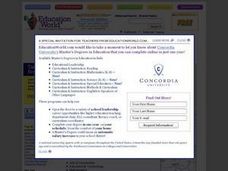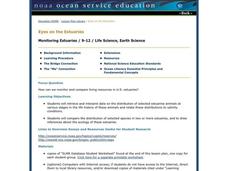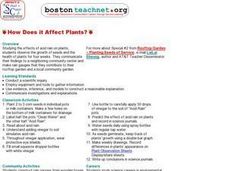Curated OER
The Role of a Plantation Mistress
Students investigate the role of a plantation mistress. In this American history lesson, students examine the household accounts kept by Thomas Jefferson's wife. Students decide what Martha Wayles Jefferson's responsibilities may have...
Curated OER
Learning from Artifacts Uncovering Clues, Large and Small
Students observe artifacts from Fort St. Louis at a website in order to make inferences about the people who lived there. They paint pottery in the style which might have been used by one of the cultural groups who inhabited the fort.
Curated OER
Can You See It, Touch It, Hear It?
Students develop and practice observational skills through lab activity.
Curated OER
How Can You Detect the Invisible?
Learners participate in a lab activity in which they examine the characteristics of radon. They identify radon's link to cases of lung cancer. They complete a radon fact sheet and answer questions to end the instructional activity.
Curated OER
Arbor Day in the Classroom
Creating an environmentally-aware classroom can be exciting and educational at the same time.
Curated OER
Leaves: All-Natural Solar Collectors
Take a good look at tree leaves and notice the adaptations for collecting solar energy. Pupils trace the margins of five different leaves onto graph paper and count the number of squares covered. They then relate this infomation to the...
Curated OER
Nuts for Peanuts: Peanut Plants, Peanut Timeline, and Peanut-s-timation!
Students complete a timeline. In this peanuts lesson, students read A Short Peanut History and use this resource to make a timeline of the history of the peanut. Students can grow peanuts in the classroom or make various peanut recipes.
Virginia Department of Education
Weather Patterns and Seasonal Changes
Get your class outside to observe their surroundings with a lesson highlighting weather patterns and seasonal changes. First, learners take a weather walk to survey how the weather affects animals, people, plants, and trees during...
Curated OER
Animals, Soil, Trees
Fourth graders describe the various kinds of soils and how plants and animals are affected by them. They describe the baic needs of plants, scoring at least a 3 or 4 on a 4-point rubic. Students are able to predict and/or infer what...
Curated OER
Zoom Out
Students explore visual perception and how objects change as distance changes. In this distance and vision lesson, students practice their scientific inquiry skills. Students practice drawing objects from different points of view in...
Curated OER
Dwellings - The Message of Houses and Their Contents, 1780-1820
Eleventh graders explore how architectural styles of the times reflected the economic status and taste of the individuals who owned the houses and how changes in the landscape and in material wealth reflect changes in technology and in...
Curated OER
Civil War
Historical poetry is lyrical in form and rich with content. After examining the differences between the Northern and Southern states before and during the U.S. Civil War, learners complete a Venn diagram and create an illustration of the...
Curated OER
Layering the Soil
Young scholars study and classify soil. In this soil science lesson, students classify soil by texture and size and study soil horizons. Young scholars label the soil types with their specific soil horizon and learn about permafrost....
Curated OER
The Water Cycle Game
Students study the path and forms of water through Earth. In this water cycle lesson, students role-play water as it moves throughout the Earth. Students play the water cycle game and complete various stations to learn about water forms...
Curated OER
Water, Water Everywhere
Students explore water. In this water cycle lesson, students conduct a scientific investigation that requires build a terrarium models of the earth. Students record their observations of the changes regarding water in the terrarium.
Curated OER
Collecting Compost
Students observe a composting box. In this soil lesson plan, students create a composting bin by using a bin, newspaper, worms, and food scraps. Students create a composting food web.
Curated OER
Eyes on the Estuaries
Students study estuaries and compare several ones in the U.S. In this estuary lesson students interpret data and compare the distribution of different species.
Curated OER
How Does it Affect Plants?
Students examine the effects of acid rain on plants. They observe the growth of seeds and the health of different plants for a month. They share their findings with the community.
Curated OER
Decomposing Artifacts
Seventh graders participate in an experiment in which they calculate the time of decomposition of different materials. In groups, they fill bags with different materials and cover them in soil. After six months, they create a line graph...
Curated OER
Bugsicles (A Frozen Insect Larva You can Find!)
Young scholars explore how animals survive in the winder. After attending a gall-collecting field trip, students place them in a freezer. Once frozen, the young scholars open the gall flay larva and observe it as the larva revives. ...
Curated OER
Alternative Alphabet
Young scholars determine and compare hieroglyph content and frequency to sentences constructed in an alternative alphabet based on symbols that mimic sounds of the alphabet. They decide which images are hieroglyphs and which ones are not.






















